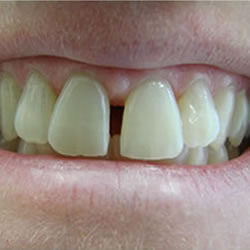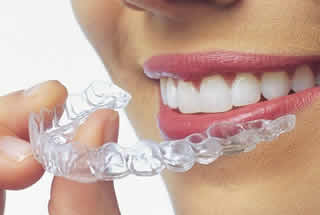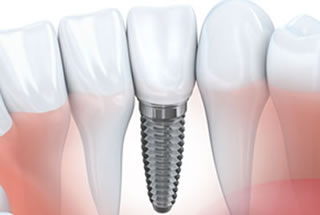
There are a number of reasons people choose to get dental veneers, which are able to hide all kinds of tooth problems. These thin porcelain shells are bonded to the front surfaces of your teeth and can transform an embarrassing smile into one to fill you with pride. One of the most common reasons that many patients opt for veneers is to hide discolored teeth.
No matter what the cause for it, teeth can lose their bright white shine over time. It can be from consuming foods and drinks that tend to stain teeth, such as red wine, coffee, berries, sodas, and other culprits. Or it can be side effects from medications, including the antibiotic tetracycline which can cause severe tooth discoloration if taken during a child’s formative years. Poor oral hygiene can also contribute to yellowed teeth, as well as tobacco use. Aging in general tends to discolor teeth too.
If your teeth show the effects of staining or yellowing, and you’d like to get that healthy youthful glow back, porcelain veneers are a good option. They provide a unique advantage of never staining, so they look like new the entire time you have them. With proper care, your veneers should last for decades or even a lifetime. That means a bright, white smile that won’t deteriorate!
Another great benefit about veneers is that they provide an instant improvement to your smile. As soon as they are placed, your smile will be transformed. If you have concerns about what they will look like, many dentists are able to use computerized photo imaging technology to give you an accurate idea of what to expect. This may alleviate any hesitations about veneers being the right solution to hide your discolored teeth. Ask your dentist today about the possibility of getting veneers to improve your smile.
Do not wait any longer. Book your appointment now and achieve the smile you have always wanted. Dr. Cruz is accepting new patients from Toronto and the surrounding area.

Veneers are a terrific option to create a dazzling smile. These shells fit right over your real teeth to hide a variety of cosmetic problems. Veneers are typically made of porcelain, giving you a natural and long-lasting smile.
How are they applied?:
Once you and your dentist decide that veneers are right for you, a small amount of your tooth enamel will be removed so that they fit correctly. An impression of your teeth will be made and sent to a dental lab for the veneers to be custom made. When they are ready, you will return to your dentist to have the veneers attached to your teeth with a special adhesive.
What are the benefits?:
It is hard for others to tell you have veneers because they look very natural. They are shaped just for your smile, and you select the color. Veneers resist stains from things like coffee, red wine, and tobacco use. Veneers are also a great choice because they fit right over your own teeth, without requiring more extensive procedures.
Are there disadvantages?:
Some patients experience increased tooth sensitivity after getting veneers due to the minor enamel removal. Also, veneers are permanent and the process cannot be reversed. Another thing to keep in mind is carefully choosing your veneer color, so that your smile isn’t overly white or unnatural.
Are veneers right for everyone?:
Veneers are great for hiding chips, cracks, gaps, or uneven teeth. They are whiten teeth that haven’t responded well to other methods. Veneers may not work for patients with weak teeth from decay, large fillings, or fractures. Patients who grind their teeth or clench their jaws may also be poor candidates because consistent wear can crack or chip the veneers.
What about maintenance?:
Veneers last ten years or more with good care. Practicing proper dental hygiene is important to avoid decay of your teeth under the veneers. Avoid nail biting or chewing on hard items like ice or pencils, which may break the thin veneers. Normal brushing and flossing is acceptable, and regular dental checkups are important in maintaining good oral health.
Are dental issues holding you back? Take control of your oral health by booking an appointment with our experienced team at our Toronto dental office.

Tooth stains, chips, cracks, and discolorations can keep you from letting others see your teeth. If you are self-conscious about your smile, then dental veneers may be the answer for you. Veneers can correct a variety of imperfections and give you a natural, beautiful smile.
What are dental veneers?:
Made from tooth-colored porcelain, veneers are attached to the front of your natural teeth. They feel just like the rest of your teeth, and are durable and do not irritate your gums. Since porcelain is resistant to stains, you’re able to eat and drink as you wish. Good oral hygiene helps keep veneers and your natural teeth strong and healthy.
What are the benefits of getting veneers?:
There’s a reason that veneers are one of the most popular options in cosmetic dentistry. They provide a solution to many problems and can dramatically improve the appearance of your smile. Veneers are the answer for tough stains or discolorations that can’t be repaired by teeth whitening. They can also make your teeth look straight and even. Veneers provide an answer for chipped or broken teeth too.
Are there any disadvantages?:
The main thing to remember is that your original tooth might need to be reshaped to a smaller size and shape to allow the new, thin coating of the veneer to be placed over it. The coating will make your tooth look like a normal, perfectly shaped tooth. However, if the veneer is ever removed, it would need to be replaced to keep your smile looking nice. Dental veneers are a life-long solution to creating your best smile.
Do not wait any longer. Book your appointment now and achieve the smile you have always wanted. Dr. Cruz is accepting new patients from Toronto and the surrounding area.

One of the most common procedures in cosmetic dentistry today is dental veneers. Many types of problems can be remedied with veneers, such as teeth that are chipped, broken, gapped, misshapen, or discolored. A veneer is a very thin shell usually made of porcelain that is bonded to the fronts of teeth to hide flaws.
Benefits:
One of the best things about dental veneers is that they immediately transform your smile the minute they are placed. They are very natural-looking because the porcelain reflects light in the same way as real teeth. Discolored or stained teeth are erased by veneers that are created in the shade you choose. Porcelain resists stains so you no longer have to worry about discoloration. You get to keep your original teeth since veneers are attached directly to them. Veneers are not only an attractive choice, they are also strong and durable.
Procedure:
The process for getting dental veneers takes two or three appointments. At the first visit, you will have an examination and X-rays to learn if you are a good candidate for veneers. If this type of restoration is suitable for you and will help you achieve your goals, your dentist can customize your smile based on your facial features, coloring, complexion, and other characteristics. A mold will be taken of your mouth and sent to a dental laboratory for your veneers to be made. When they are ready in about a week, you will return to the dental office to have them attached to check for things like fit and color. The veneers will then be permanently bonded to your teeth and final modifications will be completed.
Care:
Your normal oral hygiene routine can be continued, including gentle regular brushing with a soft toothbrush and daily flossing. Regular dental checkups every six months should be maintained for checkups and cleanings. Avoid chewing or biting on hard items so that your veneers will not chip or break. If you follow these guidelines, your veneers should last a very long time.
Do not let another day go by without taking care of your dental needs. Request an appointment now at our Toronto dental office!

If you’re looking for an instant smile upgrade, dental veneers might be your answer. These thin customized shells made of porcelain or resin are used to cover numerous kinds of teeth imperfections. They are bonded to the fronts of your teeth to give you a beautiful smile. Why do people choose dental veneers for their smiles? The list of benefits is long!
Natural look:
Veneers reflect light in the same way as real teeth, making them look very realistic. Their thin width allow them to blend into your smile.
Color:
Veneers are custom-made to match the exact shade of white that you desire. You and your dentist can work together to match your natural tooth shade, or to choose a brighter color that whitens your smile.
Durability:
Veneers can last for ten years or longer with proper care. Once bonded onto your teeth, they are quite strong if you avoid doing things like biting into hard foods.
Versatility:
Dental veneers hide nearly every cosmetic tooth flaw that you might have. Discolorations, chips, cracks, gaps, misalignment and more can all be covered. Veneers can even give your teeth a new shape and size if desired.
Functionality:
Veneers can strengthen teeth that are cracked, fractured or chipped. This can improve your teeth’s function at the same time as transforming their appearance.
Stain resistance:
Porcelain and resin both resist stains so that you can expect your veneers to remain the same color as when you got them. However, it’s smart to avoid consuming items that are known staining culprits.
Speed:
It may take a week or longer to create your personalized veneers in a dental lab, but the actual process of applying them takes only about an hour.
Ease on teeth:
Very little of your natural tooth must be removed in order to place veneers. The nerves of your teeth should remain unaffected, decreasing the risk of sensitivity.
Recovery:
You can return to your normal routine as soon as your veneers have been placed, as there is no period of recovery or adjustment needed.
Maintenance:
Veneers do not require any kind of special maintenance. You can just continue with your normal brushing and flossing routines.
Ready to transform your smile? Schedule your appointment today at our Toronto dental office.

When your appearance gets you down because you are embarrassed about flaws in your smile, dental veneers can turn your life around. The process is simple and in only a couple of visits to your dentist, you’ll have a brand new beautiful smile.
Getting dental veneers is painless. Your dentist just takes impressions of your natural teeth and then the mold is used to create veneers just for you in a dental lab. The thin shells, usually made of porcelain or composite resin, are bonded onto the fronts of your teeth to hide all kinds of imperfections.
There are many reasons that patients consider veneers to transform their smile. Here are some common ones:
- Stains – severely discolored and stained teeth sometimes do not respond to teeth whitening treatment, or the results just aren’t dramatic enough to make you happy with your smile. The shade of dental veneers is chosen by you and your dentist, so you can achieve the exact color you’d like.
- Chips – teeth that are chipped or cracked are easily hidden under veneers. The damaged portion of the tooth is supplemented so that it looks brand new, and the hard coating supplied by the veneers protects the weakened tooth from further damage.
- Misalignment – if braces or other orthodontia didn’t work for you or if you want to avoid the sometimes lengthy and embarrassing process, veneers make your smile appear straight and perfect. Uneven or crooked teeth can cause low self-esteem, but veneers will make you proud to smile.
- Gaps – extra spaces between your teeth can also be upsetting, especially large gaps that might even call for invasive procedures like dental implants. Your dentist may be able to cover awkward gaps with veneers to give you an even smile without any pain or prolonged recovery time.
Veneers aren’t for every dental problem, but many of them can be addressed with this easy and quick solution. Ask your dentist if they are right for you.
Ready to transform your smile? Schedule your appointment today at our Toronto dental office.







 E-Mail Us
E-Mail Us  416-595-5490
416-595-5490








